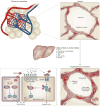Hepatopulmonary syndrome: update on pathogenesis and clinical features
- PMID: 22751459
- PMCID: PMC10963041
- DOI: 10.1038/nrgastro.2012.123
Hepatopulmonary syndrome: update on pathogenesis and clinical features
Abstract
Hepatopulmonary syndrome (HPS) is a serious vascular complication of liver disease that occurs in 5-32% of patients with cirrhosis. The presence of HPS markedly increases mortality. No effective medical therapies are currently available and liver transplantation is the only established treatment option for HPS. The definition and diagnosis of HPS are established by the presence of a triad of liver disease with intrapulmonary vascular dilation that causes abnormal arterial gas exchange. Experimental biliary cirrhosis induced by common bile duct ligation in the rat reproduces the pulmonary vascular and gas exchange abnormalities of human HPS and serves as a pertinent animal model. Pulmonary microvascular dilation and angiogenesis are two central pathogenic features that drive abnormal pulmonary gas exchange in experimental HPS, and thus might underlie HPS in humans. Defining the mechanisms involved in the microvascular alterations of HPS has the potential to lead to effective medical therapies. This Review focuses on the current understanding of the pathogenesis, clinical features and management of HPS.
Conflict of interest statement
The authors declare no competing interests.
Figures

Similar articles
-
Hepatopulmonary Syndrome.Dig Dis Sci. 2015 Jul;60(7):1914-23. doi: 10.1007/s10620-015-3593-0. Epub 2015 Mar 3. Dig Dis Sci. 2015. PMID: 25732713 Review.
-
The role of receptor tyrosine kinase activation in cholangiocytes and pulmonary vascular endothelium in experimental hepatopulmonary syndrome.Am J Physiol Gastrointest Liver Physiol. 2014 Jan 1;306(1):G72-80. doi: 10.1152/ajpgi.00178.2013. Epub 2013 Nov 7. Am J Physiol Gastrointest Liver Physiol. 2014. PMID: 24200956 Free PMC article.
-
Placental growth factor inhibition targets pulmonary angiogenesis and represents a therapy for hepatopulmonary syndrome in mice.Hepatology. 2018 Aug;68(2):634-651. doi: 10.1002/hep.29579. Epub 2018 May 11. Hepatology. 2018. PMID: 29023811
-
Pulmonary angiogenesis in a rat model of hepatopulmonary syndrome.Gastroenterology. 2009 Mar;136(3):1070-80. doi: 10.1053/j.gastro.2008.12.001. Epub 2008 Dec 3. Gastroenterology. 2009. PMID: 19109954 Free PMC article.
-
Potential Clinical Targets in Hepatopulmonary Syndrome: Lessons From Experimental Models.Hepatology. 2018 Nov;68(5):2016-2028. doi: 10.1002/hep.30079. Hepatology. 2018. PMID: 29729196 Free PMC article. Review.
Cited by
-
Hepatopulmonary Syndrome.Dig Dis Sci. 2015 Jul;60(7):1914-23. doi: 10.1007/s10620-015-3593-0. Epub 2015 Mar 3. Dig Dis Sci. 2015. PMID: 25732713 Review.
-
Diagnostic Potential of 99mTc-macroaggregated Albumin Scintigraphy in the Diagnosis of Hepatopulmonary Syndrome: Insights from Two Case Studies and Critical Review of Literature.Indian J Nucl Med. 2024 Jul-Aug;39(4):304-308. doi: 10.4103/ijnm.ijnm_18_23. Epub 2024 Nov 18. Indian J Nucl Med. 2024. PMID: 39790825 Free PMC article.
-
Plasma Reticulocalbin 3 (RCN3) is a Novel Biomarker for the Early Diagnosis of Hepatopulmonary Syndrome in Cirrhotic Patients.Lung. 2025 Mar 20;203(1):50. doi: 10.1007/s00408-025-00807-5. Lung. 2025. PMID: 40111510
-
Role of extracellular vesicles in liver diseases and their therapeutic potential.Adv Drug Deliv Rev. 2021 Aug;175:113816. doi: 10.1016/j.addr.2021.05.026. Epub 2021 Jun 2. Adv Drug Deliv Rev. 2021. PMID: 34087329 Free PMC article. Review.
-
Multiple recurrent intracerebral hemorrhages and hepatopulmonary syndrome.Neurol Clin Pract. 2019 Aug;9(4):e27-e29. doi: 10.1212/CPJ.0000000000000593. Neurol Clin Pract. 2019. PMID: 31583193 Free PMC article. No abstract available.
References
-
- Rodriguez-Roisin R, Krowka MJ. Hepatopulmonary syndrome—a liver-induced lung vascular disorder. N Engl J Med. 2008;358:2378–2387. - PubMed
-
- Swanson K, Wiesner R, Krowka M. Natural history of hepatopulmonary syndrome: impact of liver transplantation. Hepatology. 2005;41:1122–1129. - PubMed
-
- Arguedas M, Abrams GA, Krowka MJ, Fallon MB. Prospective evaluation of outcomes and predictors of mortality in patients with hepatopulmonary syndrome undergoing liver transplantation. Hepatology. 2003;37:192–197. - PubMed
-
- Arguedas M, Singh H, Faulk D, Fallon MB. Utility of pulse oximetry screening for hepatopulmonary syndrome. Clin Gastroenterol Hepatol. 2007;5:749–754. - PubMed
Publication types
MeSH terms
Grants and funding
LinkOut - more resources
Full Text Sources
Other Literature Sources

